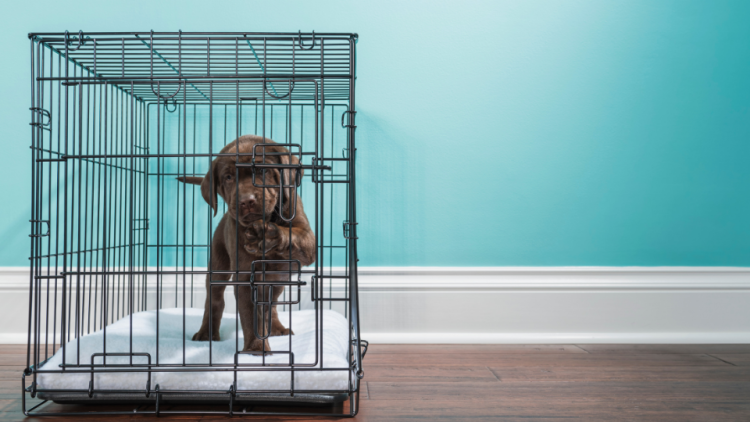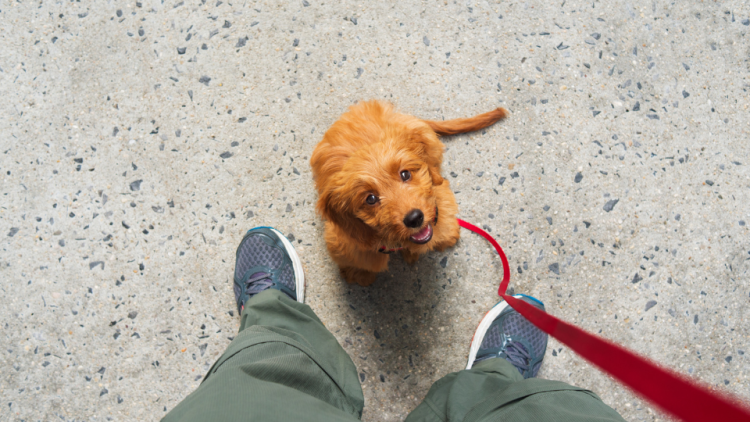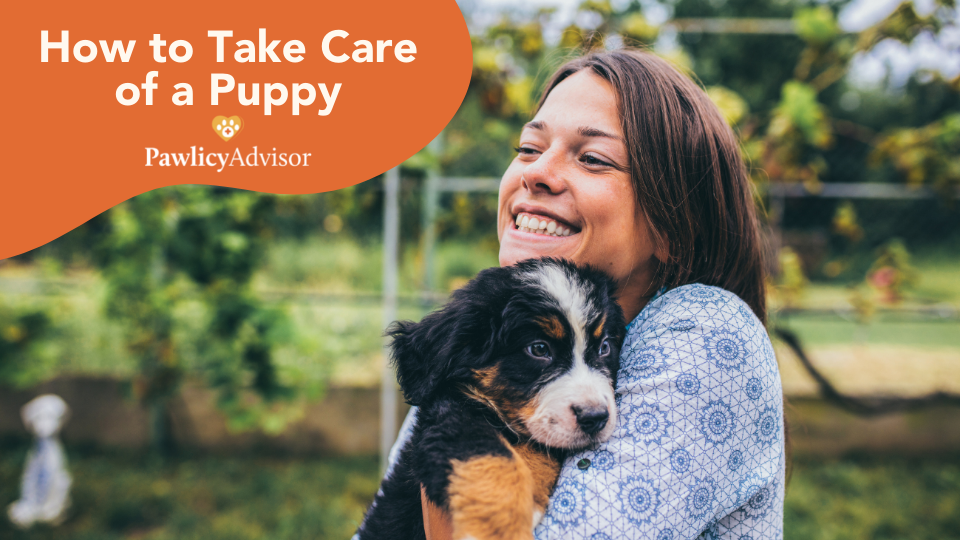Bringing a puppy home is incredibly exciting, but it can also be a little stressful. With pet parenthood comes big responsibility, and your new family member will need more than just food and snuggles to thrive. Learning how to take care of a puppy might feel overwhelming at times, but our guide is here to help you become the best pet parent possible.
Protect Your Puppy With Pet Insurance Is Pet Insurance Worth It?
Here’s everything you need to know about caring for a puppy:
- Stock up on essential puppy supplies
- Prepare your home for the puppy
- Welcome puppy with love
- Give your puppy a safe place
- Get pet insurance and go to the vet
- Vaccinate, microchip, and spay or neuter
- Provide a healthy diet and exercise
- Start puppy socialization ASAP
- Work on obedience, leash, and potty training
- Stay on top of routine pet care
1. Stock up on essential puppy supplies
Start by stocking up on the most critical puppy care supplies. Some of the most important things you need for a puppy are:
- Crate, kennel, or playpen
- Dog bed or bedding
- Food and water bowl
- Chew toy
- Collar
- Poop bags
If you’re wondering, “What products does my puppy need?” download the checklist of puppy supplies for a complete run-down you can refer to at any time.
2. Prepare your home for the puppy
Just like young children, puppies are naturally curious. They’ll be eager to explore their new home and everything in it, which can easily get them into dangerous situations. You’ll need to puppy-proof your home to protect them from safety hazards. Create a safe environment for your new family member by ensuring they’re out of harm's way of items such as:
- Chemicals and toxins
- Electrical cords and cables
- Rugs
- Plants (Check out ASPCA’s poisonous plant list)
- Breakable objects
- Trash
- Valuables
In addition, make sure to vacuum or sweep the floors frequently to remove any small hazards your puppy could swallow and choke on.
3. Welcome your puppy with love
The bond you have with your puppy begins the moment they arrive in your home. You can strengthen this bond through affection, playtime, grooming, training, and participation in different activities like dog sports or dog shows.
Here are some things you can do to make your puppy feel welcome and safe in its new home:
- Research the breed ahead of time to understand their unique needs
- Give your puppy a name and use it often
- Let them sleep on your chest to feel the warmth of your heart and hear its beat.

4. Give your puppy a safe space
Homes can be hectic. There are people coming and going, children playing, dishwashers running, music playing… You might think your puppy is unaffected by all the chaos, but they need a quiet place to retreat from all the sensory stimuli. Give them a safe haven — like a kennel, crate, or bed — where they can go when they need to be alone and rest.
It might feel like “punishment” at first, but soon they’ll learn to love their safe spot. This helps teach your puppy how to be independent and prevent attachment. It might be hard, but avoid suffocating your pup with too much attention and give them space to become a confident canine without you constantly by their side.
5. Get pet insurance and go to the vet
Within a few days of taking your new puppy home, you will need to find a primary care veterinarian and bring your puppy in for an exam. The vet will check your puppy’s eyes, ears, nose, and mouth, assess their skin and coat, listen to their lungs and heart, and record their vital signs. They’ll also go over a puppy vaccination schedule, deworming schedule, recommended diet, and other essential tips to take care of your puppy.
Take some time to prepare your puppy for its first vet visit to ensure that it is a positive experience for both of you:
- Go on a few car rides before the appointment, so they don’t associate cars with a fear of the vet's office.
- Bring your puppy into the waiting room to give them a chance to get used to the new environment.
- Try to stay as calm as possible during the appointment because your worries can cause your puppy stress.
Before your first appointment, you’ll want to sign up for puppy insurance to lower future vet bills. Puppies have a long list of vet visits before them, and a pet insurance policy can get you reimbursed for up to 100% of the cost for covered treatments (after you meet your deductible). By signing up early, you can maximize the use of your policy and ensure no pre-existing condition gets excluded from your insurance coverage.
Shop Pet Insurance For Puppies
6. Vaccinate, microchip, and spay or neuter
Over your puppy's first six months, it's your responsibility to visit the vet often. In addition to the initial health exam that confirms there are no congenital puppy conditions you need to worry about, your four-legged friend will follow a puppy vaccine schedule to protect their vulnerable immune system against communicable disease.
Typically, puppies should be neutered or spayed at around six months of age. The American Veterinary Medical Association (AVMA) supports early neutering and spaying. Delaying this procedure can lead to increased incidences of testicular cancer in male dogs and mammary tumors in females. There’s also an increased risk of unintended pregnancy and escaping to find a mate that might result in physical harm.
You can also talk to your vet about microchipping. A microchip is a permanent identification form that can reunite you with your beloved pet if it becomes stolen or lost.
How Much Does it Cost to Microchip a Dog?
7. Provide a healthy diet and exercise
Another essential puppy care tip is to provide a healthy diet. You should opt for nutrient-dense pet food specifically formulated for growing puppies. Always follow your veterinarian's advice on how to pick the best dog food for your puppy’s nutritional needs, but AAFCO brands that have undergone nutrient analysis and/or clinical trials are a great place to start. Don’t forget to provide access to clean, fresh water at all times, and be sure to avoid giving your puppy human foods unsafe for dogs.
Your puppy will also need enough exercise to help them constructively use their surplus energy. Once your veterinarian confirms your puppy is fully vaccinated, take him or her on regular walks and make yourself available for lots of playtime. Prepare yourself for a commitment that is definitely fun but will also involve some ankle-biting, sharp teeth, and “zoomies.”
8. Start puppy socialization ASAP
It’s a good idea to introduce your puppy to a variety of sounds, experiences, and people during the early weeks and months. A well-socialized puppy will grow up to be a well-mannered adult dog and be able to cope with different situations they are likely to encounter later in life.
While socialization occurs throughout the first year of life, the first three months are the most crucial time for puppies to learn about their environment.

9. Work on obedience, leash and potty training
Learn how to train a puppy and start right away. Obedience training helps build confidence in a puppy and is essential in their development towards becoming a well-behaved adult. You can teach your puppy obedience and impulse control with commands such as Sit, Wait, and Leave It.
Leash training is not only important for your puppy’s safety but it also sets the stage for teaching basic commands, like come, sit, and stay.
Finally, potty training is the best way to correct inappropriate behaviors before they become bad habits. Puppies need to urinate frequently, so you should give them an opportunity to relieve themselves at a designated "potty spot" immediately after drinking or eating. However, accidents will happen, so be prepared, patient, and consistent.
Training your dog requires a ton of patience, but your well-behaved dog will be worth all the effort.
10. Stay on top of routine pet care
Routine or preventive pet care is crucial for puppies. During the first few months, puppies are more susceptible to sudden bouts of illnesses that can be serious if not caught and treated on time. If you observe signs like poor weight gain, vomiting, lack of appetite, difficulty breathing, constipation, or coughing, be sure to contact your vet. This dog care tip is essential throughout your pet's entire life.
In addition, visit the vet regularly for annual pet wellness exams, and keep in mind that your puppy will need booster vaccines for dogs.
Use your pet insurance plan to offset the cost of caring for a puppy and provide them with a healthy foundation for life. Pawlicy Advisor can help you compare pet insurance plans from leading providers to help you find the best option for your puppy.
Key Takeaways
- Taking care of a puppy is a big and often expensive responsibility.
- The most important thing you need to know about taking care of a puppy is that they are fed, socialized, loved, and has access to health care.
- Pet insurance can help guarantee your puppy will always have accesss to the gold-standard care they deserve by covering the cost of veterinary care if they get injured or fall ill.
FAQs on Puppy Care
How to take care of a puppy at night
When it comes to taking care of your puppy during the night, there are several rules we’d recommend sticking to:
- Stick to a regular bedtime routine.
- Decide where your puppy will sleep and stick to it.
- Keep bedtime as calm as possible and give your puppy praise when they settle where you want them to.
- Sleep in the same room for the first few nights until the puppy adjusts to being without their mother.
- If possible, place something that smells of the puppy’s mother where they sleep to help to comfort them.
- Be prepared for toilet breaks during the night.
- If your puppy cries or barks during the night, it’s okay to comfort them until they get more confident sleeping alone.
How long can a puppy be left alone during the day?
Once your puppy is comfortable at your house, you can leave them in their crate for an hour or more at a time. Remember, puppies need to urinate frequently.
In general, puppies up to ten weeks of age can’t hold their bladder for more than one hour. Puppies between ten and 12 weeks old can generally hold their bladder for about two hours, whereas three months old puppies can usually hold it for an hour for each month they have been alive. Dogs older than six months can usually hold their bladder for up to six hours but even grown canines should not be left alone for longer than six to eight hours without a bathroom break.
How to take care of a puppy while working
Having a puppy while working full time can be challenging, but there are strategies that can help you make it work:
- If your workplace allows it, bring your puppy along with you.
- Speak to your superior about work-from-home opportunities, at least until your puppy gets used to the new home.
- If you expect your puppy to rest quietly while you’re at work, consider giving them an exercise session before you head off to work.
- See if you can arrange to come home during your lunch hour to check in with your puppy. Also, try to tire them out with socialization, exercise, and play prior to leaving for long periods of time.
How much does it cost to take care of a puppy?
The estimates for the first year of puppy ownership fall between $1,600 and $2,000. This includes dog food, grooming, training, boarding/doggy daycare, toys, preventive therapies, veterinary care, spaying/neutering, and pet insurance.
